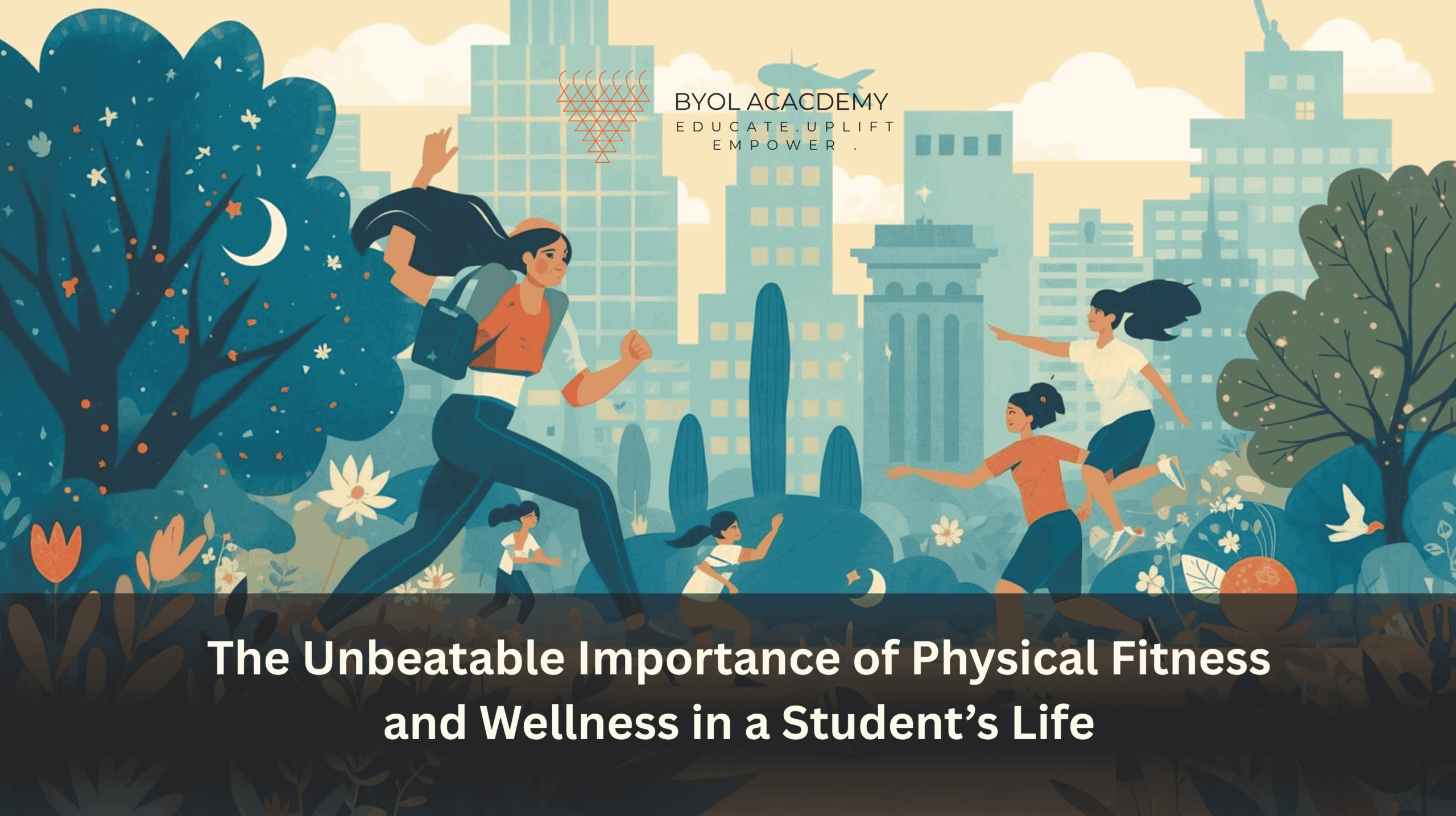Artificial Intelligence is now being increasingly used in medicine and is even being trained to predict how diseases might progress […]
The Unbeatable Importance of Physical Fitness and Wellness in a Student’s Life

In today’s fast-paced world, where academic competition and screen-based lifestyles dominate a student’s routine, the importance of physical fitness and overall wellness cannot be overstated. We live in an era that celebrates mental sharpness- the ability to study longer, memorize faster, and perform better. yet often forgets the foundation of that fuels it all “the body”.
A healthy body is not just a vessel for learning but the engine that powers focus, energy, and success. Balancing mind and body is no longer optional, it’s essential for true academic and personal growth.
Good health is not merely the absence of disease as you rightly point out, it is a balanced state of physical, mental, and social well-being. For students facing immense pressure, maintaining physical fitness is essential to ensure better concentration, profound emotional balance, and ultimately, higher overall productivity and fulfilment.
Redefining the Duo: Fitness as Action, Wellness as Outcome
Before diving into the benefits, it’s vital to clarify the two terms that form the foundation of this discussion.
Physical Fitness refers to the functional ability of the body to effectively and efficiently perform work, meet daily demands, and handle unforeseen challenges without undue fatigue. It is the measure of your strength, endurance, flexibility, and cardiovascular health.
Wellness, on the other hand, is a broader, multi-dimensional concept that involves a positive, active approach to living. It is the conscious pursuit of choices and activities that lead to optimal health. It doesn’t just include proper nutrition and physical activity; it embraces:
- Emotional Stability: The capacity to manage feelings and cope with stress.
- Intellectual Vitality: The desire to learn, challenge the mind, and grow.
- Social Connection: Building strong relationships and a sense of belonging.
- Mental Peace: Utilizing practices like mindfulness to maintain clarity and focus.
When schools and parents emphasize physical education and Overall well-being, they are not merely encouraging participation in sports; they are nurturing habits that build lifelong health literacy, well-being, and resilience. Thus, the importance of physical fitness and wellness in a student’s life becomes a vital, core part of education itself-the ultimate preparatory course for adulthood.
The Cognitive Blueprint: Feeling Academic Success
A student’s daily schedule often includes long hours of sitting, limited physical movement, and high mental pressure. This sedentary reality slows metabolism and encourages “brain fog.” Regular physical activity is the necessary counter-force, providing a direct physiological path to superior academic performance.
1. Enhanced Focus and Alertness
Regular movement helps in dramatically improving blood circulation, ensuring the brain receives a steady and robust supply of oxygen and nutrients. When the brain is better oxygenated, cognitive functions are sharpened. Students who engage in activities like running, swimming, cycling, or yoga often display a superior ability to stay alert in class and focus deeply on complex tasks for sustained periods.
2. Boosting Memory and Learning Capacity
Exercise is proven to stimulate the production of BDNF (Brain-Derived Neurotrophic Factor), often called “Miracle-Gro for the brain.” BDNF promotes neurogenesis (the creation of new brain cells) and strengthens synapses, the connections responsible for learning and memory storage. This means that a physically active student is not just sharper in the moment, they are actually building a more robust physical structure for long-term memory retention, which is critical when facing exams and retaining foundational knowledge.

3. Fighting Brain Fatigue
Fitness enhances endurance, not just in the legs, but in the mind. By improving the efficiency of the cardiovascular system, the body uses energy resources more effectively. This translates directly to an ability to manage demanding study sessions or creative projects late into the day without the sudden energy crashes that plague sedentary individuals.
The evidence is clear that the importance of physical fitness and wellness in a student’s life is connected not just to passing grades, but to the quality and depth of their learning.
The Stress Shield: Mental and Emotional Armor
The student experience is defined by high pressure, performance anxiety, peer competition, the fear of missing out (FOMO), and the constant ping of digital life. Physical fitness does not only build a strong body-it also strengthens the mind, acting as a crucial defence mechanism against burnout and anxiety.
1. The Chemistry of Happiness
Exercise helps release endorphins, commonly known as “happy hormones,” which serve as natural painkillers and mood elevators. This powerful internal pharmacy effectively reduces anxiety, lifts depression, and improves overall mood. For students, this leads to greater emotional stability and stronger ability to manage pressure during challenging times such as final exams or demanding project deadlines- turning stress into strength and focus into success.
2. Managing the Cortisol Overload
Stress floods the body with cortisol, a hormone designed for short-term “fight.” When stress is chronic, high cortisol levels lead to fatigue, poor sleep, and weight gain. Physical activity metabolic excess cortisol, helping to reset the body’s stress response system and promoting a return to equilibrium.
3. The Power of Restorative Practices
Wellness practices such as meditation, deep breathing, and mindfulness further support mental clarity and reduce fatigue by training the mind to remain present and non-reactive. Incorporating these habits even 10 minutes of quiet reflection or gentle yoga, demonstrates the importance of physical fitness and wellness in a student’s life, specifically in maintaining focus and stability amid modern distractions and the temptation of comparison.
Building Lifelong Habits and Life Skills
The habits developed during school years often continue into adulthood, shaping professional careers and personal lives. Physical activity is a powerful incubator for essential character traits.
1. Discipline and Consistency
A physically active student learns the value of consistency and discipline. Waking up for an early workout, showing up for practice, or committing to a training schedule teaches a student to prioritize long-term goals over immediate comfort. These are the exact skills needed to manage a professional workload, save money, or maintain healthy relationships later in life.
2. Time Mastery and Goal Setting
Integrating fitness into a busy schedule requires flowless time management and self-control. Active students quickly learn to be efficient, dedicating focused time slots to both study and movement, preventing the dangerous tendency toward procrastination. Furthermore, setting fitness goals like running 5 Km or more or improving a bench-press, teaches the mechanics of goal setting, progress tracking, and celebrating incremental success.
3. Teamwork and Resilience
Whether through team sports or group projects, fitness activities cultivate crucial social skills that the value of teamwork, the responsibility of leadership, and the grace of sportsmanship when facing defeat. Learning to collaborate, communicate under pressure, and quickly recover from a setback (resilience) are qualities that leader seek out and that underpin strong personal relationships.
Schools and parents should encourage physical education not as an optional subject, but as a core part of personality and leadership development. Recognizing the importance of physical fitness and wellness in a student’s life at an early stage can lead to a stronger, happier, more ultimately confident, and more valuable generation.
Conclusion: The Investment with the Highest Return
The journey toward success begins with good health. Students who give equal importance to studies and fitness are not dividing their attention; they are, in fact, multiplying their capacity to meet life’s challenges.
The true importance of physical fitness and wellness in a student’s life lies in the synergistic balance it creates between mind and body, high intensity work and restorative rest, academic ambition and personal contentment. True education must aim not only to sharpen the intellect but also to strengthen the body and nurture the spirit.
By making wellness a fundamental priority, a student ensures they have the energy, the focus, and the emotional strength required to not just survive the academic years, but to truly thrive and emerge as a well-rounded, capable adult.
In every sense, a fit student is the foundation for a successful life and, collectively, a fit nation. It’s an investment that pays the highest interest.
References
- World Health Organization (WHO). Physical Activity and Young People — https://www.who.int/news-room/fact-sheets/detail/physical-activity
- Ministry of Youth Affairs & Sports, Government of India — Khelo India Programme — https://yas.nic.in/
- NCERT Class 12 Physical Education Textbook (Latest Edition, 2024–25) — Chapter 1: Planning in Sports & Physical Fitness — https://ncert.nic.in/
- Centers for Disease Control and Prevention (CDC). Physical Activity Guidelines for Students — https://www.cdc.gov/physicalactivity/
- UNICEF India — Adolescent Health and Well-Being — https://www.unicef.org/india/


